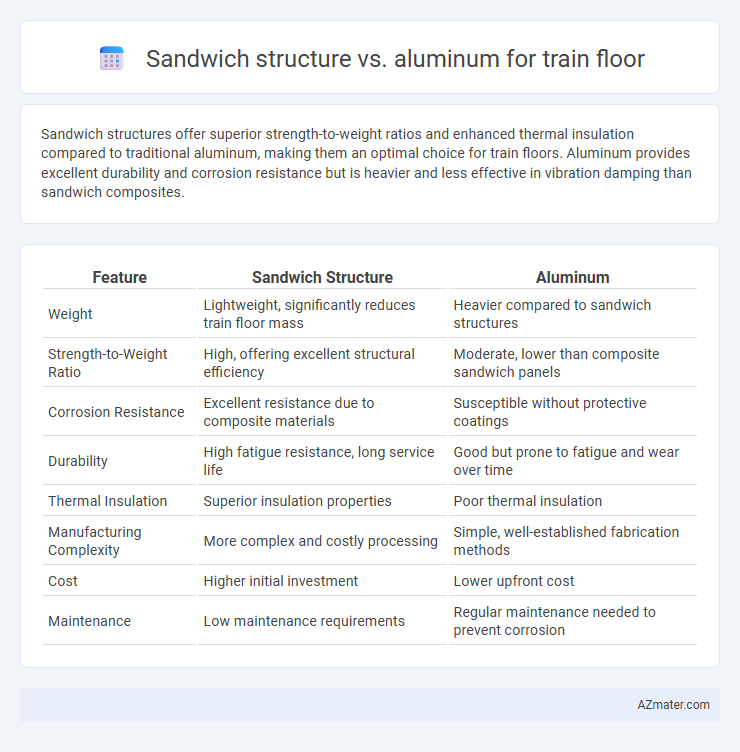Sandwich structures offer superior strength-to-weight ratios and enhanced thermal insulation compared to traditional aluminum, making them an optimal choice for train floors. Aluminum provides excellent durability and corrosion resistance but is heavier and less effective in vibration damping than sandwich composites.
Table of Comparison
| Feature | Sandwich Structure | Aluminum |
|---|---|---|
| Weight | Lightweight, significantly reduces train floor mass | Heavier compared to sandwich structures |
| Strength-to-Weight Ratio | High, offering excellent structural efficiency | Moderate, lower than composite sandwich panels |
| Corrosion Resistance | Excellent resistance due to composite materials | Susceptible without protective coatings |
| Durability | High fatigue resistance, long service life | Good but prone to fatigue and wear over time |
| Thermal Insulation | Superior insulation properties | Poor thermal insulation |
| Manufacturing Complexity | More complex and costly processing | Simple, well-established fabrication methods |
| Cost | Higher initial investment | Lower upfront cost |
| Maintenance | Low maintenance requirements | Regular maintenance needed to prevent corrosion |
Introduction to Train Floor Materials
Train floors require materials that balance strength, lightweight properties, and durability under constant mechanical stress. Sandwich structures, typically composed of lightweight core materials like foam or honeycomb, offer superior stiffness-to-weight ratios compared to traditional aluminum, which is known for its corrosion resistance and ease of fabrication. Selecting between sandwich structures and aluminum depends on specific performance criteria such as impact resistance, thermal insulation, and maintenance needs in rail applications.
Overview of Sandwich Structure Technology
Sandwich structure technology in train floors utilizes a core material, such as foam or honeycomb, sandwiched between two layers of composite or metal skins, offering high strength-to-weight ratios and enhanced energy absorption compared to traditional aluminum floors. This design significantly improves thermal insulation, reduces noise, and contributes to overall vehicle weight reduction, leading to fuel efficiency and lower operational costs. The adaptability and durability of sandwich structures make them a superior choice for modern rail applications seeking lightweight, high-performance flooring solutions.
Key Properties of Aluminum Floors
Aluminum floors in trains offer exceptional strength-to-weight ratio, enhancing fuel efficiency and load capacity. Their corrosion resistance ensures long-lasting durability even under harsh environmental conditions and heavy usage. Aluminum's excellent thermal conductivity also contributes to improved temperature regulation within train compartments.
Strength and Durability Comparison
Sandwich structures, composed of a lightweight core material bonded between two strong face sheets, offer superior strength-to-weight ratios and enhanced impact resistance compared to traditional aluminum for train floors. Aluminum provides excellent corrosion resistance and good fatigue strength but is generally heavier and less effective in absorbing dynamic loads, leading to potential long-term durability issues. The sandwich construction improves structural integrity by distributing stresses more evenly, resulting in greater durability and reduced maintenance costs in high-load rail applications.
Weight Reduction and Efficiency
Sandwich structures for train floors offer significant weight reduction compared to traditional aluminum, often achieving up to 30-50% lighter panels. This decrease in weight directly translates to improved fuel efficiency and lower operational costs by reducing the energy required for acceleration and braking. Enhanced load distribution and vibration damping properties of sandwich composites also increase structural efficiency and passenger comfort.
Thermal and Acoustic Insulation Performance
Sandwich structures for train floors provide superior thermal insulation with low thermal conductivity core materials such as foam or honeycomb, significantly reducing heat transfer compared to aluminum floors. Acoustic insulation performance is enhanced in sandwich panels due to their multi-layer construction, effectively dampening vibrations and reducing noise transmission inside train cabins. In contrast, aluminum floors exhibit higher thermal conductivity and poorer sound dampening capabilities, making them less efficient for thermal and acoustic comfort in rail applications.
Cost Analysis: Sandwich vs Aluminum
Sandwich structures typically offer a lower initial material cost compared to aluminum for train floors, driven by the use of lightweight core materials such as foam or honeycomb combined with composite skins. Aluminum, while more expensive upfront due to raw material and fabrication costs, provides superior durability and easier recyclability, potentially reducing lifecycle costs over time. Cost analysis must consider factors like maintenance frequency, weight savings affecting energy consumption, and expected service life to determine the most economical choice for train flooring.
Fire Safety and Regulatory Compliance
Sandwich structures offer superior fire resistance compared to aluminum for train floors due to their composite layers, which can include fire-retardant core materials that slow flame spread and reduce smoke emissions. Aluminum floors, while lightweight and durable, tend to have higher thermal conductivity, increasing the risk of rapid heat transfer during a fire, potentially compromising passenger safety. Regulatory standards such as EN 45545-2 and NFPA 130 mandate stringent fire safety criteria that sandwich structures more readily meet, ensuring compliance with smoke toxicity, flame spread, and heat release requirements critical for railway applications.
Maintenance and Lifecycle Considerations
Sandwich structures offer superior corrosion resistance and improved impact absorption compared to aluminum, significantly reducing maintenance frequency and costs for train floors. Aluminum, while lightweight and strong, is prone to fatigue and corrosion, leading to more frequent inspections and potential repairs throughout its lifecycle. The enhanced durability and lower maintenance demands of sandwich panels contribute to extended service life and reduced total lifecycle expenses in rail transportation applications.
Future Trends in Train Floor Materials
Sandwich structures consisting of lightweight cores and high-strength facings offer enhanced weight reduction and energy absorption compared to traditional aluminum train floors, driving future trends in material innovation. Advances in composite technology enable improved durability and thermal insulation while maintaining structural integrity, responding to increasing demands for fuel efficiency and safety. Emerging hybrid solutions combine aluminum's recyclability with sandwich panel benefits, positioning them as sustainable choices for next-generation train flooring systems.

Infographic: Sandwich structure vs Aluminum for Train floor
 azmater.com
azmater.com